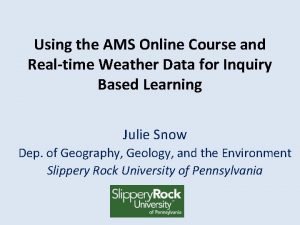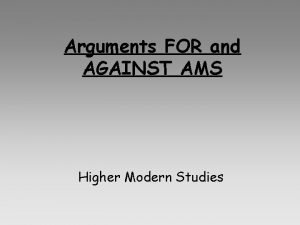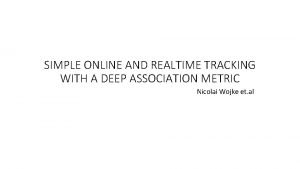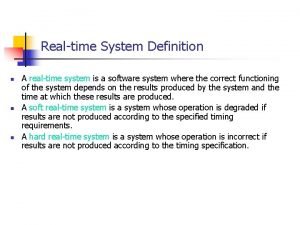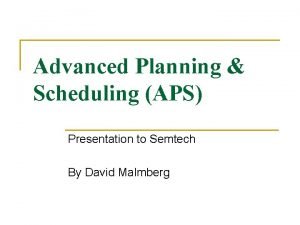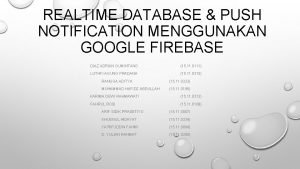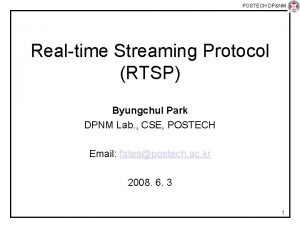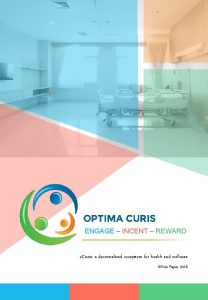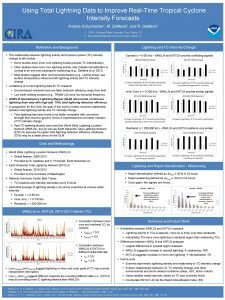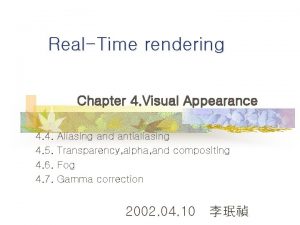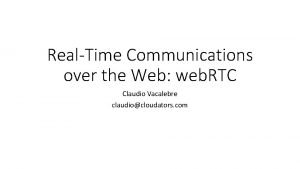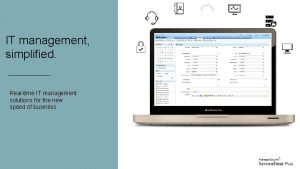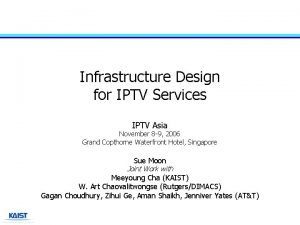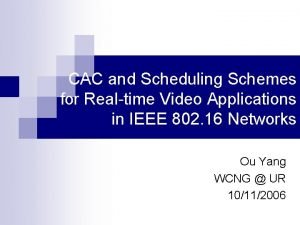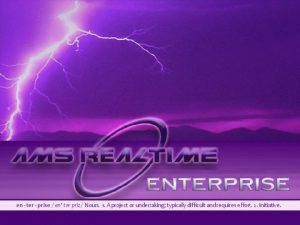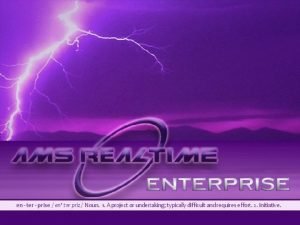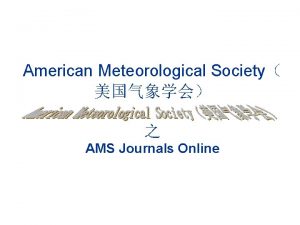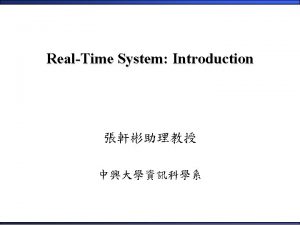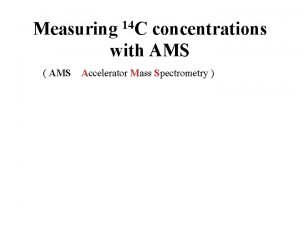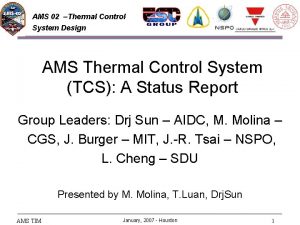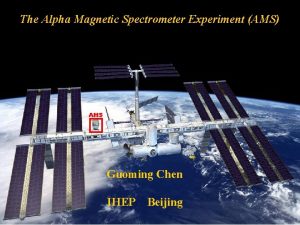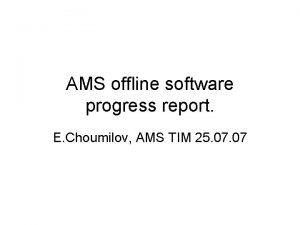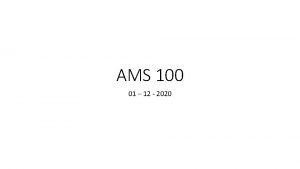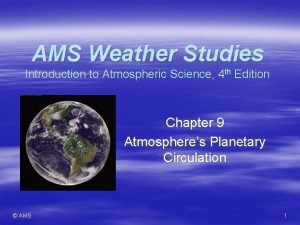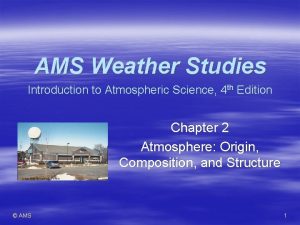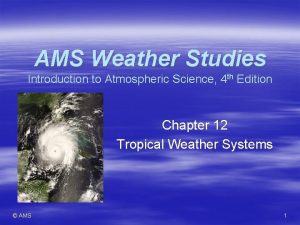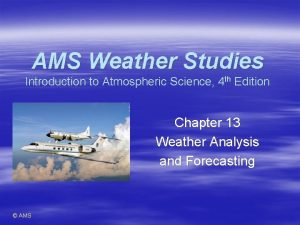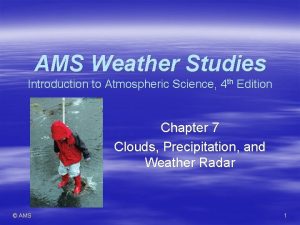Realtime Weather Education Through AMS Online Weather Studies



















- Slides: 19

Real-time Weather Education Through AMS Online Weather Studies Ira W. Geer American Meteorological Society Washington, DC Elizabeth W. Mills American Meteorological Society Washington, DC Joseph M. Moran American Meteorological Society Washington, DC Robert S. Weinbeck SUNY College at Brockport, NY James A. Brey University of Wisconsin-Fox Valley Menasha, WI William A. Porter Elizabeth City State University Elizabeth City, NC

What is Online Weather Studies? • An introductory college-level, distance-learning course on the fundamentals of atmospheric science designed and serviced by the American Meteorological Society (AMS) and licensed by undergraduate institutions for local offering • Turnkey package with electronic and printed components; students learn about weather as it happens in near real-time • Nationally implemented in the Fall 1999 Semester and licensed by 185 institutions

Online Weather Studies Institutions Online Weather Studies Licensed Institutions Participating in Geosciences Diversity/National Dissemination Project

Online Weather Studies History • Course idea came out of AMS Undergraduate Faculty Enhancement Program (1994, 1995) participant recommendations and success of Data. Streme Atmosphere precollege teacher enhancement course (implemented in 1996) • Developmental work supported by the National Science Foundation (NSF) Division of Undergraduate Education • Pilot tested at 14 colleges in the Spring 1999 Semester by UFEP participants and Data. Streme Atmosphere leaders • Nationally implemented in the Fall 1999 Semester and evaluated by 23 course instructors after the Spring 2000 Semester

Online Weather Studies Evaluation Question Average Response My offering of Online Weather Studies was a success. 3. 6 I would recommend Online Weather Studies to a colleague. Student response to the course was positive. 3. 7 Online Weather Studies motivates student learning. 3. 5 Online Weather Studies materials are scientifically sound. 3. 8 Respondents used a scale from 1 to 4: 1 = strongly disagree, 2 = disagree, 3 = agree, 4 = strongly agree. 3. 5

Online Weather Studies Evaluation • Positive aspects of Online Weather Studies – “Superb organization of course materials. ” – “The online exercises were excellent. They were well connected to each other. I appreciate the repetition of important concepts like the hand-twist model. ” – “(Students’) ability to work at their own speed and work with real-time data. ” • How the course influences way of teaching weather – “My classroom has changed from lecture based to activity based. ” – “I spend a lot less time preparing for lectures and let the students work more on their own. ” – “I now assign more web-based assignments to the students as a result of Online Weather Studies. ”

Online Weather Studies Growth 185 146 103 74 31

Online Weather Studies Growth

Course Components - Textbook • Online Weather Studies Second Edition – – Authored by Joseph M. Moran Copyright 2002 AMS 15 chapters, 416 pages Full color • Features up-to-date comprehensive descriptions of weather phenomena and weather and climate research topics • Topical Coverage and sequence similar to that found in most introductory texts • Each chapter written to a weekly topic; components are the Case-in-Point, Driving Question, chapter narrative, and Essay(s)

Course Components – Study Guide • Learning Investigations – 30 investigations total, two per chapter – Second part of each investigation accessed via the Course Homepage and involves analysis and interpretation of current weather information – Every activity provides a hands-on, labtype learning experience • Textbook Chapter Review and Critical Thinking Questions

Course Components - Homepage • • Daily Weather Summary Supplemental Information Online Learning Investigations Weekly Critical Thinking/ Diversity component • Student Resources • Current Weather Maps and Charts • Semester Archives

Course Components – Faculty Materials • Faculty CD – Faculty manual – Textbook images – Test bank questions • Faculty Homepage – Weekly discussions – Answer keys – Critical Thinking/Diversity Component • Examines a specific critical thinking cognitive skill and an affective attribute that relate to each week's student investigations and describes an activity that models some aspect of critical thinking • Applies critical thinking to diversity topics

Offering Online Weather Studies • Course design enables offering by experienced meteorology professors and those with no prior teaching experience nor formal training in atmospheric sciences • Instructional settings range from traditional lecturebased to totally online • Example: University of Wisconsin offerings – Traditional offering through UW – Fox Valley – Completely online offering through UW Colleges

Geosciences Diversity Project • Expand the offering of geoscience study opportunities to students who are members of groups underrepresented in the sciences, mathematics, and technology and increase the participation by minorities in science careers, including atmospheric science and science teaching • Components – Minority serving institutions commit to offering Online Weather Studies for at least one semester – Course instructors invited to workshops at National Weather Service (NWS) Training Center and AMS Annual Meeting – Institutions partner with local NWS offices for academic advising and mentoring for students who demonstrate interest and potential for further studies leading to possible careers in the geosciences

Geosciences Diversity Project • Eligible Minority Serving Institutions – – – Historically Black Colleges and Universities Hispanic Serving Institutions Tribal Colleges and Universities Alaska Native or Native Hawaiian Serving Institutions Colleges and universities with a 30% or greater minority student population • Support for 4. 5 -year period ending in 2006 – NSF Opportunities for Enhancing Diversity in the Geosciences – NSF Course, Curriculum and Laboratory Improvement – National Dissemination

Diversity Project Participants Historically Black Colleges and Universities • Alabama A&M University (AL) • Bethune-Cookman College (FL) • Bluefield State College (WV) • Delaware State University (DE) • Elizabeth City State University (NC) • Fayetteville State University (NC) • Hampton University (VA) • Jackson State University (MS) • Livingstone College (NC) • Morehouse College (GA) • North Carolina Central University (NC) • Paine College (GA) • Prairie View A&M University (TX) • South Carolina State University (SC) • Talladega College (AL) • University of the Virgin Islands (VI) • Virginia State University (VA) • West Virginia State College (WV) Hispanic Serving Institutions • Arizona Western College (AZ) • California State University, Bakersfield (CA) • California State University, Fresno (CA) • California State University, Northridge (CA) • Houston Community College-Southeast (TX) • Passaic County Community College (NJ) • Santa Ana College (CA) • Texas A&M University-Kingsville (TX) • University of Texas at Brownsville (TX) Hispanic Serving Institutions (cont. ) • University of Texas of the Permian Basin (TX) • Texas A&M International University (TX) • University of Houston-Downtown (TX) • University of Puerto Rico at Cayey (PR) • University of Puerto Rico, Mayagüez (PR) • Ventura College (CA) Tribal Colleges and Universities • Blackfeet Community College (MT) • Little Big Horn College (MT) Minority-serving institutions • Alaska Pacific University (AK) • Columbia Basin College (WA) • Cosumnes River College (CA) • Gate. Way Community College (AZ) • Laney College (CA) • Medgar Evers College of CUNY (NY) • Metropolitan Community Colleges (MO) • Prairie State College (IL) • Sacramento City College (CA) • Southside Virginia Community College (VA) • Tidewater Community College (VA) • Triton College (IL) • Tyler Junior College (TX) • University of California, Riverside Extension (CA) • Univ of North Carolina at Pembroke (NC) • University of North Dakota, Indians into the Geological Sciences (ND)

Diversity Project Workshops • NWS Training Center Workshop – Presentations by NOAA experts – Basic principles and special topics in meteorology – Modes of offering Online Weather Studies – Field trips • AMS Annual Meeting Activities – One-day workshop on diversity issues related to the course – Instructors present posters and attend meeting sessions

Future Directions • By 2006, at least 100 minority-serving institutions will offer Online Weather Studies through the Geosciences Diversity Project and thousands of undergraduate minority students will be introduced to studies in meteorology. • AMS will encourage more institutions with atmospheric and related science degree program to implement the course. These institutions tend to have large introductory weather classes. • AMS will continue to enhance course components to improve and update the student learning experience.

Contact Information • www. ametsoc. org/amsedu/online/info • American Meteorological Society 1120 G Street, NW, Suite 800 Washington, DC 20005 • 202 -737 -1043 • onlinewx@dc. ametsoc. org
 Ams realtime weather maps central
Ams realtime weather maps central Ams modern studies
Ams modern studies Simple online and realtime tracking
Simple online and realtime tracking Paradigm shift from women studies to gender studies
Paradigm shift from women studies to gender studies The definition of a real-time system.
The definition of a real-time system. Gullistan carpet
Gullistan carpet Firebase push notification android
Firebase push notification android Realtime streaming protocol
Realtime streaming protocol Halthywa
Halthywa The forrester wave real time interaction management q2 2017
The forrester wave real time interaction management q2 2017 Lightning realtime
Lightning realtime Visual rendering
Visual rendering Real time operating system concepts
Real time operating system concepts Realtime communications
Realtime communications Realtime it
Realtime it Realtime it
Realtime it Realtime it
Realtime it Iptv infrastructure
Iptv infrastructure Cac realtime
Cac realtime Realtime forex
Realtime forex
